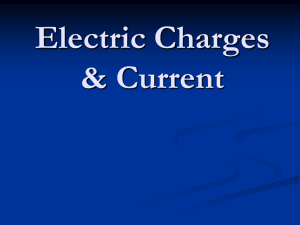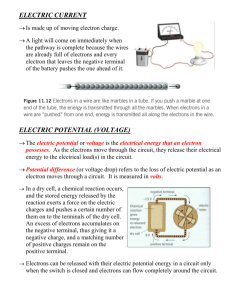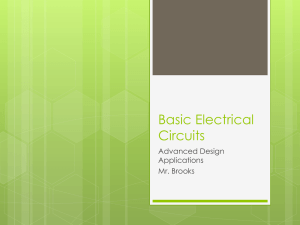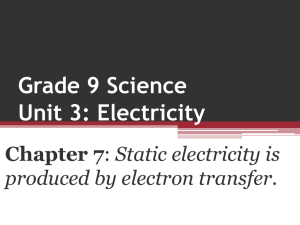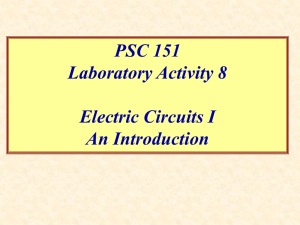Electric Charges & Current
advertisement
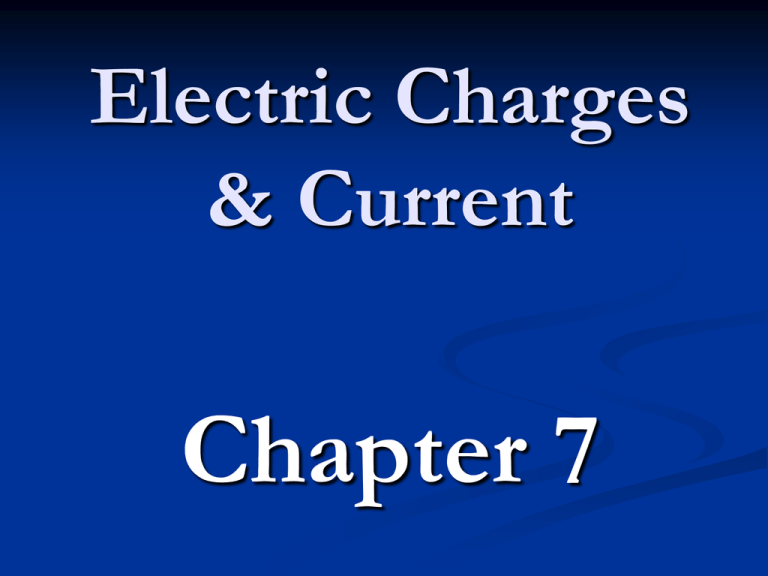
Electric Charges & Current Chapter 7 Types of electric charge Protons w/ ‘+’ charge “stuck” in the nucleus Electrons w/ ‘-’ charge freely moving around the nucleus in orbits Conductors Allow the easy flow of electricity loosely bound electrons that are free to move from atom to atom metals like aluminum, gold, copper and silver Insulators Insulators – resists the flow of electrons hold more tightly to their valence electrons: plastic, rubber, glass Interactions between charges same as in magnetism Unlike magnetism were on a magnet there is always a + on one end and a – on the other end of the magnet electrical charges can exist alone Like charge repel Opposite charges attract Electric Fields Exert a force through the force field in all directions from the charged particle When a charged particle enters the force field of another particle it is either attracted or repelled The diagram represents stronger force as the lines get closer & closer together Static Charge Latin word “Stasis” which means “Stays” Objects are typically “Neutral” w/ the same # of protons and electrons They can become “charged” by gaining or losing electrons – NOT PROTONS! – They stay in the nucleus! The buildup of these charges is “Static Electricity” In Static Electricity the charges build up and STAY; they don’t flow as they do in electric currents Transferring Static Charge Friction – transferred from rubbing i.e. get shocked after walking on the carpet Conduction – transferred by direct contact w/ another object – hair standing on end w/ Van de Graff machine Induction – the force field of a highly negatively charged object pushes the electrons away from nearby objects causing them to become + charged, they then are attracted to each other. i.e. statically charged balloon attracts small pieces of torn up paper Static Discharge Objects don’t hold a static charge forever – objects tend toward equilibrium – they “want” to be neutral When electrons move toward this equilibrium – static discharge occurs Humidity – water (a polar molecule) vapor in the air pulls electrons off negatively charged objects, preventing static charges to build up Sparks & Lightning - objects reaching static equilibrium Circuit Measurements Electric Current - Flow of electrons through a material Electrical Potential – Similar to potential energy (lifting something higher against the force of gravity gives it greater potential to do work, increasing its potential energy.) When given the opportunity, objects will move from higher potential energy to an area of lower potential energy Electrical potential is related to their electrical fields and not to height – as electrons build up on one side they “want” to flow to an area w/ less potential Voltage Voltage – causes current to flow through an electrical circuit Volt – unit of measure to measure this potential A Voltage Source (battery or generator) is required to maintain the electrical potential in a circuit. Electrical Current Water flowing thru a pipe depends on more than the angle of the pipe. It also depends on the length of the pipe, diameter of the pipe and if the pipe is clogged or open. Electrical Current is measured in Amperes Amount of Electrical Current ( amps) depends on more than just Voltage, it depends on the Resistance found in the circuit. Electrical Resistance the opposition to the flow of electricity – measured in Ohms – symbol is the Greek letter Omega Water flowing thru a pipe depends on more than the angle of the pipe. It also depends on the length of the pipe, diameter of the pipe and if the pipe is clogged or open. Electricity will take the path of least resistance The greater the resistance, the less current there is for a given voltage. a. Longer wires have greater resistance than short wires b. Thin wires have more resistance than thick wire c. High conductors have less resistance than insulators Series Circuits Series Circuits – provides only one path for the electrons to follow 1. A break in the circuit stops the flow of electricity to all other parts of the circuit 2. With multiple light bulbs (more resistance) the current reduces & the dimmer the lights become 3. Ammeters should be wired in series Parallel Circuits Parallel circuits – the different parts of the circuit are on separate branches A break (burn out light bulb) in the circuit doesn’t stop the flow to the remaining devices Multiple light bulbs will remain the same brightness since the resistance is not decreasing as it does in a series circuit. Each pathway can be separately switched off w/out affecting the others Household circuits – Wired in parallel, with a standard of 120 volts Voltmeters are wired in parallel Parallel Circuits The more paths the LESS the resistance Water example again: added pipes coming from a large tank will allow more water to flow out that a single pipe. Therefore as resistance degreases, current increases; they are inversely proportional Schematic Diagrams All circuits need at least the following Power supply, wire, resistors, other items include switches, connectors, meters, etc. There is a set of standard symbols used to represent these items in a diagram of the circuit Batteries -Electrochemical cells 1. Converts chemical energy into electrical energy 2. Consists of two different metals – the electrodes 3. Electrodes immersed in a chemical “bath” that conducts electricity called the electrolyte 4. The part of the electrodes above the electrolyte is the terminal and used to connect the battery to the circuit. There is a chemical reaction between the electrodes and the electrolyte resulting in a buildup of electrons on one of the terminals (it becomes the “-“ terminal) The other terminal gives up its electrons and becomes the “+” terminal. This difference sets up the electrical potential of the system = Volts When cells are connected in series the voltages of the cells are added together Dry cell & Wet cell Wet Cell – the electrolyte is a liquid (car battery) i. In a car battery, Electrolyte is sulfuric acid the “+” terminal is lead oxide and the “-“ terminal is lead metal Dry Cell – the electrolyte is not really dry; but is a paste i. Standard AA, C, D type batteries, electrolyte is a paste. The “+” terminal is That’s all
